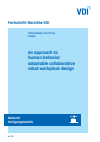An approach to human behavior adaptable collaborative robot workplace design
Zusammenfassung
Studies show that collaborative robots that can explain in real time what a human is doing and the passive underlying intention are likely to be positively perceived by human workers. In this respect, a seamless flow of information between human and machine systems in realtime is expected. This will push future collaborative robots‘ ability to work with humans at higher collaboration levels, including real cooperation or responsive collaboration with humans. This is crucial for collaborative robot applications to be used not in a similar way traditional industrial robots are used, i.e., rather than replacing humans engaging in real collaboration with them. Therefore, this work presents a bottom-up method for collaborative robot workplace design that uses models of individual human attention, intention, and action for cycle time synchronization to improve the performance of action prediction in planning the collaborative robot workplace design process. Contents Abbreviations and Acronyms VIII Symbols X Abstract XI Zusammenfassung XII 1 Introduction 1 1.1 Overview . . . . . . . . . . . . . . . . . . . . . . . . . . . . . . . . . . . . . 1 1.2 Human individual collaborative ...
Schlagworte
Aufmerksamkeit-Intention-Handlung menschliches Handlungsmodell Mensch-RoboterKollaboration kollaborative Roboterarbeitsplatzgestaltung symbiotischer Arbeitsplatz Attention-intention-action human action model human-robot collaboration collaborative robot workplace design symbiotic workplace- 1–16 1 Introduction 1–16
- 17–43 2 State of the art 17–43
- 87–126 5 Tests and results 87–126
- 127–136 6 Discussions 127–136
- 137–178 7 Conclusion and outlook 137–178
- 179–210 Bibliography 179–210

